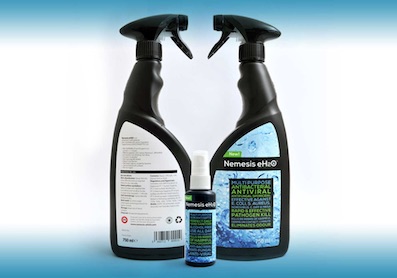 Cleanzine: your weekly cleaning and hygiene industry newsletter 10th July 2025 Issue no. 1170
Cleanzine: your weekly cleaning and hygiene industry newsletter 10th July 2025 Issue no. 1170
Your industry news - first
The original and best - for over 20 years!
We strongly recommend viewing Cleanzine full size in your web browser. Click our masthead above to visit our website version.
What's in your Pub toilet? Some pubs are making a potentially dangerous error
 By Adrian Gee-Turner of Sterling Presentation Health
By Adrian Gee-Turner of Sterling Presentation Health
"The hospitality sector is under tremendous pressure, and generally speaking has responded to the Covid challenge with enthusiasm and professionalism.
Social distancing and new hygiene measures have imposed extra costs during difficult times, so their efforts are to be applauded.
However, recent visits to pubs have caused a certain amount of dismay because of the hand sanitisation facilities provided in some lavatories.
Most venues seem to be offering low cost anti-bacterial hand sanitisers - presumably working on the assumption that an anti-bacterial sanitiser will also kill viruses, such as Coronavirus. Unfortunately, that is not always the case; many hand sanitisers have moderate effectivity against bacteria and almost no effectivity against viruses.
The danger is that pub customers may not conduct effective handwashing because of a flawed belief that the hand sanitiser is killing any viruses on their hands. Clearly, the best and lowest cost solution would be to encourage every visitor to wash their hands effectively with soap. If a hand sanitiser is offered, it should be effective at killing viruses and any product with this capability will display this information on the label.
When assessing effectivity claims on labels, it is important to understand the 'kill percentage' figures. If you spray a million target micro-organisms with a 99.9% kill disinfectant; 1,000 will remain. Products claiming to be effective against Coronavirus should be compliant with EN 14476, which requires a minimum Log 4 (99.99%) reduction.
Nemesis eH2O has passed EN 14476 and significantly exceeded the log kill requirement. Readers will be further assured with its active ingredient (stabilised hypochlorous acid) being included in the US Environmental Protection Agency's list of active ingredients for use against SARS-CoV-2.
It is also important to note the 'contact time' of a disinfectant, which is the time that it takes to achieve the required disinfection. Nemesis eH2O acts very quickly - much faster than bleach for example. However, some products take significantly longer so they should remain wet for an extended period.
Ventilation with fresh air helps to reduce the potential for infection, but consideration should be given to the survival times of coronavirus on different surfaces. Research (Kampf, G. et al, 2020) investigating Human Coronavirus Survival Times on Surfaces, found that it lasted around four days on wood, glass and paper, and nine days on plastic.
Where large spaces are to be disinfected, fogging should be considered. Again, effectivity and contact time should affect the choice of disinfectant, but it will also be preferable to avoid products that are hazardous to humans - staff and customers. Partly due to its high levels of effectivity against micro-organisms, Nemesis eH2O is also proving extremely popular because it contains no hazardous substances, which means there are no COSHH restrictions, no toxic residue and PPE is not necessary.
In summary, our message to the hospitality sector is to continue with the excellent measures that are now in place, but if you offer a hand sanitiser, make sure it is ant-viral."
10th September 2020







